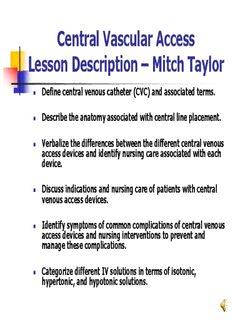
Central Vascular Access Lesson Description Mitch Taylor - ACLS 4 You PDF
Preview Central Vascular Access Lesson Description Mitch Taylor - ACLS 4 You
Central Vascular Access Lesson Description – Mitch Taylor Define central venous catheter (CVC) and associated terms. Describe the anatomy associated with central line placement. Verbalize the differences between the different central venous access devices and identify nursing care associated with each device. Discuss indications and nursing care of patients with central venous access devices. Identify symptoms of common complications of central venous access devices and nursing interventions to prevent and manage these complications. Categorize different IV solutions in terms of isotonic, hypertonic, and hypotonic solutions. Guidelines U.S. Department of Health & Human Services Provides a website for national guidelines for evidenced based practice National Guideline Clearinghouse http://www.guidelines.gov/ http://www.guidelines.gov/summary/summar y.aspx?view_id=1&doc_id=8338#s24 GLOSSARY OF TERMS Biocompatibility - the quality of not having toxic or injurious effects on biological systems. - Dorland's Medical Dictionary Central Venous Catheter – tip in distal third of the Superior Vena Cava (SVC) Central Venous Tunneled Catheter – tip in SVC, but insertion is tunneled under the skin before accessing the vein. Distal - means furthest from the heart (perspective) on the body, but on a catheter, the distal part would be the furthest away from the infusion ports. Perspective For example, when we are talking about hypertonic, isotonic, and hypotonic solutions, we are talking about it from the perspective of inside the vessel. Isotonic Vessel Cell Cell Cell Cell Cell Isotonic • The vessel always wants to look like America’s Top Model – perfect or always look isotonic. It will do what ever it needs to accomplish that look. Hypertonic Vessel Cell Cell Cell Cell Cell Perspective So, a hypertonic solution means it is thicker or more concentrated than what is normally in the vessel. And, because the body seeks to normalize things in the vessel, it will send fluid to the vessel to get it to look normal or isotonic again. It robs from the cells and tissues to achieve the look of isotonic in the vessel. What this does then is add more fluid into the vessels and onto the heart, which the heart sends to the kidneys to urinate out of the body. Hypertonic Vessel More Fluid Cell Cell Cell Cell Cell Perspective A hypotonic solution then does the opposite. It has less stuff or is thinner or is less concentrated than what is normally in the vessel. So the body will shunt fluid out of the vessel into the cells in order to make the vessel look normal again. This will reduce the amount of fluid in the vessel and reduce the amount of work on the heart.
Description: